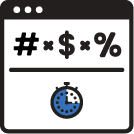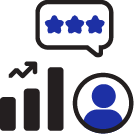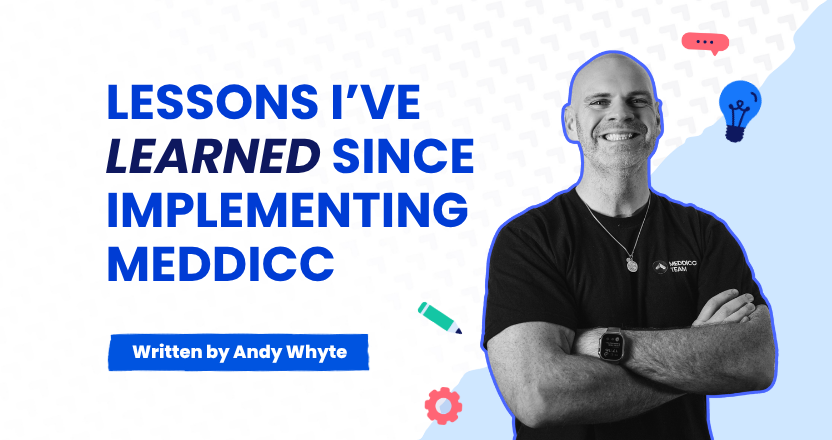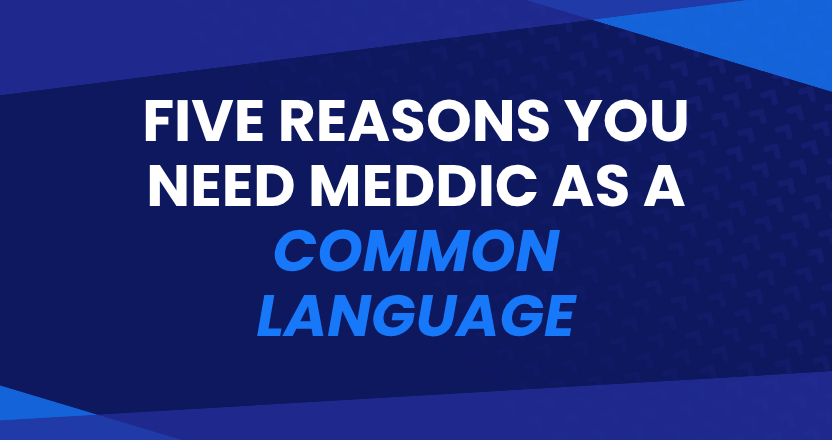I have worked in a variety of enterprise sales organization’s from being the first employee at a company who didn’t even have a product to Series A, B, C, D and E startups, through to the behemoth that is Oracle where I was one of tens of thousands of sellers,
Across this journey, I have seen a variety of deployments of MEDDICC from a 30-minute session as part of an onboarding plan presented by a sales administrator through to the most cost-intensive manner imaginable including flying an entire sales team from all corners of the planet to Dallas for a week-long training course.
I have seen firsthand the importance of the sales leadership team, and their level of adoption directly relates to the effectiveness of a MEDDICC deployment.
In my last two sales leadership roles, I have implemented MEDDICC as the first initiative I undertook upon starting the position. On both occasions, I had several initiatives I came in considering deploying. In both instances, MEDDICC was by far the most pertinent methodology for me to implement.
In the first implementation, MEDDICC helped us control a sales organization that had no forecasting function at all. Further still, they called deals to close despite not having any communication from the customer for weeks. MEDDICC helped that organization achieve its annual target, which was a crucial requirement to help them towards their next fundraising milestone. The next funding round gave us the ability to grow the sales team from 6 to 20 in 12 months and grow revenue by over 100% in the same period.
In my second implementation of MEDDICC, I took over responsibility for the EMEA region of a Series E startup with a commercial team of 16. Two years before I joined, the sales team had shifted from a mostly freemium model to selling paid plans. In the 12 months before I joined, they were beginning to focus upmarket toward the enterprise. By the time I joined, the focus was to shift entirely toward enterprise customers.
The EMEA region was lagging far behind the U.S. team. The U.S. team was twice as likely to win a deal compared to the EMEA, but on average, they would achieve more than twice as much revenue too.
Due to a strict focus on qualification via MEDDICC and an emphasis on going upmarket meant that within three quarters, we had doubled the average order value and reduced the average deal cycle time by 30%.
Along this journey of various implementations of MEDDICC, I’ve learned some valuable lessons which I will share with you now:
1. You need to go all-in on MEDDICC
MEDDICC is binary. You either use it, or you don’t; there is no middle ground.
MEDDICC has to become part of the universal language which your organization uses to talk about deals.
At the top of the funnel, the sales development team needs to be focused on identifying stakeholders such as Coaches, Champions, and Economic Buyers. Marketing needs to be using MEDDICC language to relate their initiatives to different contact types and the various stages of the sales process relating to MEDDICC.
Across the business’s operations side, sales operations should embrace MEDDICC within their systems, such as the CRM and any technology laid over the top of the sales process such as AI tools.
Existing processes need to shift to embrace MEDDICC; for example, QBR formats should be adapted to include MEDDICC language.
2. Front Line Managers are THE Most Important Adopters
The most significant factor to the success of your MEDDICC implementation lies in your front-line sales managers’ hands. If they do not embrace MEDDICC in everything you do, your MEDDICC initiative will die.
Despite this, the front-line managers are rarely given the support they need to make MEDDICC a success. My advice for any organization planning on implementing MEDDICC would be that you spend two hours training the sales management team for every hour you plan to spend training sellers on MEDDICC.
I’d strongly advise against undertaking any MEDDICC implementation initiative without a critical focus on training and supporting the first-line managers as a priority.
3. You need the Full Support of the Executive Team
Find the world’s fastest-growing enterprise technology companies, and you’ll MEDDICC. Look into their executive teams, and you’ll find other MEDDICC companies on their resume. Whether it’s a CEO, CFO or CMO, if they have worked with MEDDICC in one place, they’ll want it in their next position, why? Because MEDDICC means predictability and at C-Level being able to forecast accurately is invaluable.
I’d wager that if the executives at your company have worked with MEDDICC before, they will be very keen to support it being implemented into their current company. However, if they are new to MEDDICC, you will need to get their buy-in and executive sponsorship as it will be imperative to your implementation meeting its full potential.
Sellers and sales managers are spinning so many plates that adding a new qualification framework plate to their workload without top to bottom support is stands the chance of being de-prioritized, and subsequently fading away as just another failed initiative.
4. Celebrate and Showcase the Quick Wins
The beauty of MEDDICC is when you overlay it over the top of a deal, it acts as a map. Often without it, a salesperson is looking for the treasure (the deal), but they have no idea what route to go on to get it. MEDDICC marks the spot and uncovers the critical path you need to go down to get there. Before this, salespeople who haven’t used MEDDICC should act as a EUREKA moment, like someone shining a light on their deal. It’s essential to capture these moments and celebrate them to bolster support across your team.*
Encourage a culture of MEDDICC celebration. Have you or someone in your team successfully qualified a Champion? Celebrate it! Have you obtained a consensus on the Decision Criteria? Celebrate!
Capture the moments in the deals where MEDDICC helped and reflect on them when you win. Likewise, if you qualify out based on MEDDICC rejoice in the time, you will have saved.
Celebrating and showcasing the wins helps to build visibility into the value of MEDDICC and subsequently will help you to gain traction upon its implementation.
5. Training Never Stops
Just like all parts of sales, you never stop learning with MEDDICC. Your peers, reports, and managers will also continue to grow and learn about MEDDICC. Through the course of writing this book, I have spoken to many people who have gone fully in with MEDDICC. From those involved with the creation of MEDDICC to people that have been using MEDDICC for over ten years, and even with people that have used MEDDICC at multiple different organization’s. At no point did I feel like I had spoken with someone who knew it all. Likewise, I learned more about MEDDICC from an elite seller like Lucy Williams-Jones in an hour’s conversation this morning than I did in over a year at a company that claimed to use MEDDICC but didn’t embrace it.
To keep moving forward with MEDDICC, you have to continue using it, share your experiences with your peers, and seek advice from others around you.
Just as important as training, the existing teams on MEDDICC will be the Onboarding of MEDDICC to new employees. If you have an onboarding process, then MEDDICC must become a part of that. Better still is to build a certification of MEDDICC and how you use it for new starters to pass. This is useful even if the person coming in has used MEDDIC, MEDDICC, or MEDDPICC before, as you may well have a varied way of using it.
6. Run Mandatory MEDDICC Reviews
To accelerate the learning and adoption of MEDDICC, I recommend implementing mandatory weekly MEDDICC deal review sessions. Sellers are to bring a deal to the session to review with the team. You go through one deal a session and either ask sellers to volunteer or run it via round-robin.
Within the hour-long session, the seller gives an overview of the background of their deal and a brief introduction to the organization they are selling to before going into each part of MEDDICC. The idea is for the team to review the deal and brainstorm areas of strength, weakness, and opportunity.
The sessions have a triple benefit:
-
The seller whose deal is being reviewed gains the team’s perspectives and will come out with a list of actions they can take to move their deal forward.
-
The team will learn from each other’s experiences both concerning MEDDICC, but also from general selling skills as well as industry or product-specific learnings.
-
The session represents a weekly engagement with MEDDICC that keeps it fresh in all your sellers’ minds. You can guarantee that while a colleague’s deal is being reviewed a seller is considering MEDDICC against their own deal/s,
Another thing to consider with running MEDDICC reviews is to invite Sales Development Reps to the sessions. SDR’s are often the talent of tomorrow, but it is a big step up to become a seller, and there isn’t much exposure they can get from the day-to-day development of deals. The MEDDICC sessions provide excellent exposure to the underlying workings of enterprise sales. Also, the more SDR’s understand what makes a well-qualified deal, the more they can look for those signs when prospecting.
7a. Use MEDDICC Confidence Scoring to Focus on Progression
I found it useful to score each part of MEDDICC from one to ten based on each part’s confidence level when reviewing a deal.
Scoring this way gives clarity over how much confidence we felt about each part. For instance, if we scored our Champion as a low score like one or two, we would know we needed to prioritize working on the Champion as an action following a deal review. Likewise, if there was a strong Competitor score, then we would know we need to focus on how we can tackle that as a priority.
If a seller came into a MEDDICC deal review with a high score on the part of MEDDICC, it gave those conducting the review permission to dig deep to the part with the highest score to qualify the seller’s confidence and try and spot potential holes in their evaluation.
7b. Watch out for Happy Ears and the Pessimist’s
The challenge I quickly found with Confidence Scoring was that the scores would vary based on the buyer’s optimism level. For instance, if a seller had the common sales condition of ‘HappyEaritus’ a condition that affects the hearing of sellers meaning that they only hear good news and proactively ignore any bad news, they may score their MEDDICC higher than a pessimistic seller.
Therefore we implemented definitions and criteria for each level of scoring. For instance, on Metrics, a score of 1-3 would be:
1-3: We have an assumption of the Metrics based on outside information, or initial conversations.
Whereas a score of 9-10 would be:
9-10: The customer openly uses our metrics/the same metrics in line with the objectives of the project, and they are the KPI’s that will dictate the success of the project.
A fantastic by-product of MEDDICC Scoring is that if you implement the scoring into your CRM system, you can gain insight into the strengths and weaknesses of a deal at a glance. I am sure there are manners you can get more sophisticated by measuring scores across sellers and improvements over time and where deals are stuck on low scores.
7c. Build MEDDICC into the sales stages
There are many organization’s that have innovated with MEDDICC by doing things such as integrating it into their sales process and subsequently, their CRM systems. There are several add-ons and standalone technologies that can help you integrate MEDDICC into your operations.
Using MEDDICC Scoring in the stages of your sales process, you can add a layer of qualification to your sales process. For instance, you may want to install it so that a deal can only pass to a late if it has a seven or higher decision process. The definition of a 7-8 Decision Process score is:
‘We strongly understand the Decision Process the deal has to undergo and have qualified with our Champion that there are no other factors except those identified. We are aligned exceptionally close to the Decision Process. We have tested the accuracy of what we have been told through each stage and found it to be mostly accurate.’
8. Marketing and MEDDICC
Brilliant marketing teams flank the world’s best enterprise sales teams. Like TripActions’ CMO Meagen Eisenberg says: the CRO and CMO should become a ‘Power Couple’.
MEDDICC and marketing can work well together for two main reasons:
-
Marketing can help drive progress on MEDDICC by running initiatives aimed at stakeholders, like the Champion and Economic Buyer. Good examples of this are events such as Champion Building events or Round Tables designed at Economic Buyers. Another super initiative I have seen marketing do with MEDDICC in mind is to create content aimed at Economic Buyer personas such as the CFO. Documents like this can be used to open up conversations with Economic Buyers.
-
If the Sales team and Marketing team work closely together, then the Marketing team can benefit from hearing about real pains that are being uncovered by the sellers in real-time. This can inform their marketing and help the Marketing team to produce more relevant content.
9. Don’t Forget the Value
While MEDDICC is an outstanding qualification framework, it is not a replacement for value selling.
If you are a Star Trek fan, think of the value selling framework as Captain Kirk, the charismatic leader, and MEDDICC as Spok, the logical sidekick. But if science fiction analogies aren’t for you, then let's stick with my earlier analogy of MEDDICC being Robin to the value-selling methodology of Batman.
To sell your solution using the Metrics you have built, and against the Pain, you have Implicated, you will need to translate your approach into value. A value framework is the best for this.
10. Always be Coaching
The first time I implemented MEDDICC into a sales team, I used to think I was a lousy teacher as it seemed no matter how many times I explained the same thing over and over, it didn’t seem to resonate. An example of this would be when sellers would describe their Metrics to me. They would just be the customer’s internal Metrics for their business, completely unrelated to the solution, such as ‘revenue’ or ‘users’. I would say time and time again:
“Metrics should be both specific to your deal and measurable. A good hack is to imagine we are going into a QBR with the customer six months after they’ve gone live and… What are the Metrics in which we would use to measure the success of our solution? Those are most likely your Metrics!”
Yet, week after week I’d find myself repeating this.
I have come to learn that it isn’t me, and it isn’t MEDDICC, it’s just that sellers and people generally have a lot going on, and they can’t take it all in. So, always be coaching. Even if you think you sound like a broken record, if you are repeating yourself in response to improvements you want to see, you haven’t repeated yourself enough!








.png)






















%201.png)












